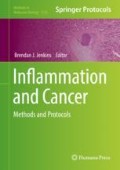Abstract
The gastrointestinal epithelium provides the first line of defense against invading pathogens, among which Helicobacter pylori is linked to numerous gastric pathologies, including chronic gastritis and cancer. Primary gastric epithelial cells represent a useful model for the investigation of the underlying molecular and cellular mechanisms involved in these H. pylori associated diseases. In this chapter, we describe a method for the isolation of primary gastric epithelial cells from mice and detection of epithelial cell adhesion molecule (EpCAM) expression in the isolated cells.
References
Wadhwa R, Song S, Lee JS, Yao Y, Wei Q, Ajani JA (2013) Gastric cancer-molecular and clinical dimensions. Nat Rev Clin Oncol 10:643–655
Celli JP, Turner BS, Afdhal NH, Keates S, Ghiran I, Kelly CP, Ewoldt RH, McKinley GH, So P, Erramilli S, Bansil R (2009) Helicobacter pylori moves through mucus by reducing mucin viscoelasticity. Proc Natl Acad Sci U S A 106:14321–14326
Yokozaki H (2000) Molecular characteristics of eight gastric cancer cell lines established in Japan. Pathol Int 50:767–777
Terano A, Mach T, Stachura J, Sekhon S, Tarnawski A, Ivey KJ (1983) A monolayer culture of human gastric epithelial cells. Dig Dis Sci 28:595–603
Aziz F, Yang X, Wen Q, Yan Q (2015) A method for establishing human primary gastric epithelial cell culture from fresh surgical gastric tissues. Mol Med Rep 12:2939–2944
Viala J, Chaput C, Boneca IG, Cardona A, Girardin SE, Moran AP, Athman R, Memet S, Huerre MR, Coyle AJ, DiStefano PS, Sansonetti PJ, Labigne A, Bertin J, Philpott DJ, Ferrero RL (2004) Nod1 responds to peptidoglycan delivered by the Helicobacter pylori cag pathogenicity island. Nat Immunol 5:1166–1174
Wee JL, Chionh YT, Ng GZ, Harbour SN, Allison C, Pagel CN, Mackie EJ, Mitchell HM, Ferrero RL, Sutton P (2010) Protease-activated receptor-1 down-regulates the murine inflammatory and humoral response to Helicobacter pylori. Gastroenterol 138:573–582
Zavros Y, Van Antwerp M, Merchant JL (2000) Use of flow cytometry to quantify mouse gastric epithelial cell populations. Dig Dis Sci 45:1192–1199
Freshney RI (2010) Primary culture. Culture of animal cells: a manual of basic technique and specialized applications, 6th edn. John Wiley & Sons, Inc., Hoboken, NJ
Pollock K, Albares L, Wendt C, Hubel A (2013) Isolation of fibroblasts and epithelial cells in bronchoalveolar lavage (BAL). Exp Lung Res 39:146–154
Ota S, Razandi M, Sekhon S, Krause WJ, Terano A, Hiraishi H, Ivey KJ (1988) Salicylate effects on a monolayer culture of gastric mucous cells from adult rats. Gut 29:1705–1714
Matuoka K, Tanaka M, Mitsui Y, Murota SI (1983) Cultured rabbit gastric epithelial cells producing prostaglandin I2. Gastroenterol 84:498–505
Konda Y, Chiba T (2002) Rat gastric mucosal epithelial cell culture. Methods Mol Biol 188:17–25
Willet SG, Mills JC (2016) Stomach organ and cell lineage differentiation: from embryogenesis to adult homeostasis. Cell Mol Gastroenterol Hepatol 2:546–559
Moyer MP (1983) Culture of human gastrointestinal epithelial cells. Proc Soc Exp Biol Med 174:12–15
Ferrero RL, Ave P, Ndiaye D, Bambou JC, Huerre MR, Philpott DJ, Memet S (2008) NF-kappaB activation during acute Helicobacter pylori infection in mice. Infect Immun 76:551–561
Acknowledgments
This work was supported by funding from the National Health and Medical Research Council (NHMRC) to RLF (project APP1079930). Research at the Hudson Institute of Medical Research is supported by the Victorian Government’s Operational Infrastructure Support Program. RLF holds an NHMRC Senior Research Fellowship (APP1079904).
Author information
Authors and Affiliations
Corresponding author
Editor information
Editors and Affiliations
Rights and permissions
Copyright information
© 2018 Springer Science+Business Media, LLC
About this protocol
Cite this protocol
Tran, L.S., Ferrero, R.L. (2018). Isolation of Mouse Primary Gastric Epithelial Cells to Investigate the Mechanisms of Helicobacter pylori Associated Disease. In: Jenkins, B. (eds) Inflammation and Cancer. Methods in Molecular Biology, vol 1725. Humana Press, New York, NY. https://doi.org/10.1007/978-1-4939-7568-6_10
Download citation
DOI: https://doi.org/10.1007/978-1-4939-7568-6_10
Published:
Publisher Name: Humana Press, New York, NY
Print ISBN: 978-1-4939-7567-9
Online ISBN: 978-1-4939-7568-6
eBook Packages: Springer Protocols

